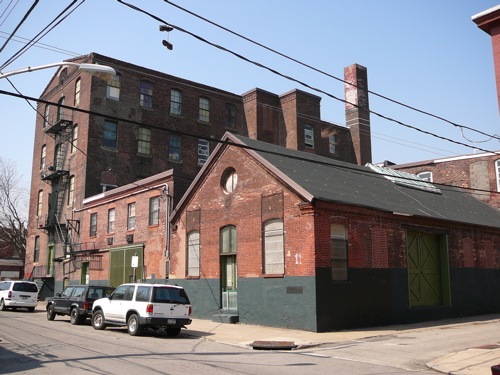
South facade along Montgomery Avenue and east facade along Hope Street (2007). Dyeing was done in the one-story gable-roofed building.
Star Carpet Mill, 1882
1801 North Howard Street, Philadelphia PA 19122
(northeast corner of Montgomery Avenue, east to Hope Street)
© Carmen A. Weber, Irving
Kosmin, and Muriel Kirkpatrick, Workshop of the World (Oliver
Evans Press, 1990).
This attractive complex of
buildings survives intact except for the upper extension
of the clearstory above the dyehouse. The buildings are
all brick, the mill on the corner extends ten bays along
Howard Street, it has five storys, with an iron fire
escape on the four bay south end. In 1878 there were
vacant lots here behind the Chatham Mills, but the next
year Blodget placed Joseph Taylor's new 1879
steam-powered mill on this corner. At that time the mill
was shared with tenants, including Waterloo Hosiery
perhaps named for the small street a half block to the
west. The Hexamer insurance map of 1891, stated the mill
was erected in 1882, it is these buildings we see today.
The survey did not list any tenants; carpet
manufacturing occupied all buildings including the
dyehouse. Dyeing was most often done by independent
firms, 1
but 80% of the
fifteen carpet mills surveyed in the West Kensington area
had their own dyehouses.
It is unclear why this carpet mill had the name Star
Mill, or when the name became associated with it. The
first time this mill was so named is in 1891, on both the
Hexamer insurance map and a Hexamer General Survey,
before then it was referred to as Joseph Taylor's mill.
The most prominent Star Mill was Thomas Craige's, the
largest spinning mill in the city in 1850.
2
Once located
three blocks south on Howard, the earlier Star Mill kept
its name through a number of changes in ownership. By
1885 it was incorporated as one of Arrott's Steam Power
Mills, retaining the same name. 3
However, there
was a Henry Taylor, a woolen yarn manufacturer, occupying
parts of floors in several of the buildings. If he had
been related to Joseph Taylor, perhaps he brought the
Star name to the carpet mill on
Montgomery.
The Taylor name is not easily traced as it occurs a
number of times in the West Kensington area.
Blodget listed two Taylor carpet makers, Joseph and
Thomas. He mentioned a third, saying that Thomas
Taylor occupied the former mill of James Taylor at
2020-2028 Hope Street, about two blocks north of
Montgomery. A 1910 Bromley Atlas associated William S.
Taylor with the Montgomery and Howard carpet mill; the
same year the Philadelphia Commercial Museum's directory
of textile industries listed Joseph Taylor and Sons,
producer of dye carpet yarns at this address. In 1916 a
Thomas Taylor was located at Howard and Berks, a block
north, employing twenty-one people in making yarns, nine
on the office staff.
Some time before 1916 Arrott Steam Power Mills, Co. had
taken incorporated the Star Mills as it had the Hampden
and Star mills further south on Howard; by 1945 the
buildings at this end of the block had no name on the
map; they may have merged with Andrew Y. Michie and Sons,
textile mills, at the north end of this block.
4
Today the Star Mill is not deserted as are many buildings
in West Kensington. It is advertising for new tenants and
potted plants festoon the fire escapes depicted in the
1885 Hexamer drawing.
1 Scranton,
Proprietary
Capitalism, p. 208.
2 Scranton,
Proprietary
Capitalism, p. 196.
3 Hexamer General Survey #86 (1866) "Star
Mills, Thomas H. Craig &
Co."
Hexamer General Survey #1889 (1885) "Star
Mills, Arrott Steam Power Mills
Co."
4 Sanborn Map
Company, 1917, and 1945.
Update May
2007 (by
Torben Jenk):
Converted to live/work studios in the late 1980s and
still serving that purpose. Buildings on the rest of the
block, to the north, have also been converted for similar
uses.
See
also:
Hexamer General Survey #2492 (1891) "Joseph
Taylor & Son, Star Carpet Mill."